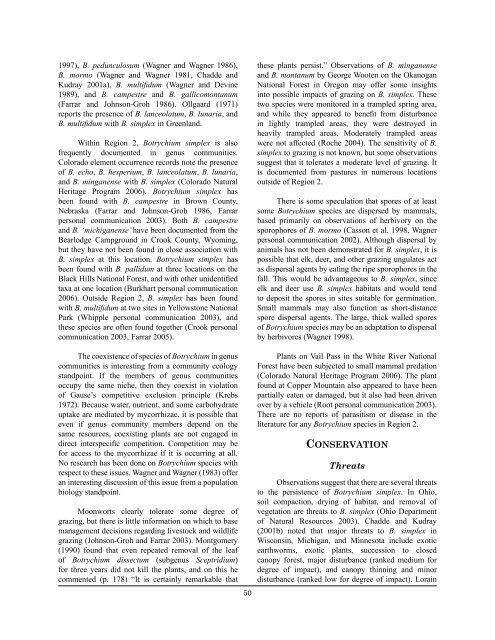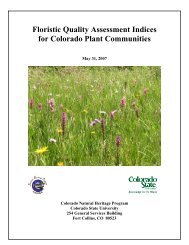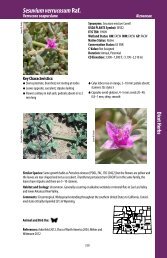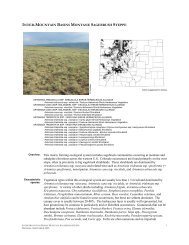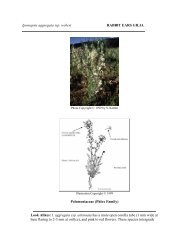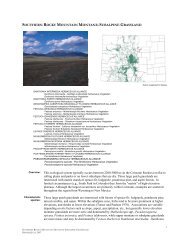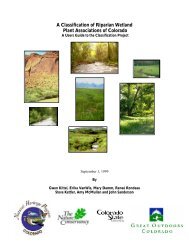Botrychium simplex E. Hitchcock (little grapefern) - Colorado Natural ...
Botrychium simplex E. Hitchcock (little grapefern) - Colorado Natural ...
Botrychium simplex E. Hitchcock (little grapefern) - Colorado Natural ...
Create successful ePaper yourself
Turn your PDF publications into a flip-book with our unique Google optimized e-Paper software.
1997), B. pedunculosum (Wagner and Wagner 1986),<br />
B. mormo (Wagner and Wagner 1981, Chadde and<br />
Kudray 2001a), B. multifidum (Wagner and Devine<br />
1989), and B. campestre and B. gallicomontanum<br />
(Farrar and Johnson-Groh 1986). Ollgaard (1971)<br />
reports the presence of B. lanceolatum, B. lunaria, and<br />
B. multifidum with B. <strong>simplex</strong> in Greenland.<br />
Within Region 2, <strong>Botrychium</strong> <strong>simplex</strong> is also<br />
frequently documented in genus communities.<br />
<strong>Colorado</strong> element occurrence records note the presence<br />
of B. echo, B. hesperium, B. lanceolatum, B. lunaria,<br />
and B. minganense with B. <strong>simplex</strong> (<strong>Colorado</strong> <strong>Natural</strong><br />
Heritage Program 2006). <strong>Botrychium</strong> <strong>simplex</strong> has<br />
been found with B. campestre in Brown County,<br />
Nebraska (Farrar and Johnson-Groh 1986, Farrar<br />
personal communication 2003). Both B. campestre<br />
and B. ‘michiganense’ have been documented from the<br />
Bearlodge Campground in Crook County, Wyoming,<br />
but they have not been found in close association with<br />
B. <strong>simplex</strong> at this location. <strong>Botrychium</strong> <strong>simplex</strong> has<br />
been found with B. pallidum at three locations on the<br />
Black Hills National Forest, and with other unidentified<br />
taxa at one location (Burkhart personal communication<br />
2006). Outside Region 2, B. <strong>simplex</strong> has been found<br />
with B. multifidum at two sites in Yellowstone National<br />
Park (Whipple personal communication 2003), and<br />
these species are often found together (Crook personal<br />
communication 2003, Farrar 2005).<br />
The coexistence of species of <strong>Botrychium</strong> in genus<br />
communities is interesting from a community ecology<br />
standpoint. If the members of genus communities<br />
occupy the same niche, then they coexist in violation<br />
of Gause’s competitive exclusion principle (Krebs<br />
1972). Because water, nutrient, and some carbohydrate<br />
uptake are mediated by mycorrhizae, it is possible that<br />
even if genus community members depend on the<br />
same resources, coexisting plants are not engaged in<br />
direct interspecific competition. Competition may be<br />
for access to the mycorrhizae if it is occurring at all.<br />
No research has been done on <strong>Botrychium</strong> species with<br />
respect to these issues. Wagner and Wagner (1983) offer<br />
an interesting discussion of this issue from a population<br />
biology standpoint.<br />
Moonworts clearly tolerate some degree of<br />
grazing, but there is <strong>little</strong> information on which to base<br />
management decisions regarding livestock and wildlife<br />
grazing (Johnson-Groh and Farrar 2003). Montgomery<br />
(1990) found that even repeated removal of the leaf<br />
of <strong>Botrychium</strong> dissectum (subgenus Sceptridium)<br />
for three years did not kill the plants, and on this he<br />
commented (p. 178) “It is certainly remarkable that<br />
50<br />
these plants persist.” Observations of B. minganense<br />
and B. montanum by George Wooten on the Okanogan<br />
National Forest in Oregon may offer some insights<br />
into possible impacts of grazing on B. <strong>simplex</strong>. These<br />
two species were monitored in a trampled spring area,<br />
and while they appeared to benefit from disturbance<br />
in lightly trampled areas, they were destroyed in<br />
heavily trampled areas. Moderately trampled areas<br />
were not affected (Roche 2004). The sensitivity of B.<br />
<strong>simplex</strong> to grazing is not known, but some observations<br />
suggest that it tolerates a moderate level of grazing. It<br />
is documented from pastures in numerous locations<br />
outside of Region 2.<br />
There is some speculation that spores of at least<br />
some <strong>Botrychium</strong> species are dispersed by mammals,<br />
based primarily on observations of herbivory on the<br />
sporophores of B. mormo (Casson et al. 1998, Wagner<br />
personal communication 2002). Although dispersal by<br />
animals has not been demonstrated for B. <strong>simplex</strong>, it is<br />
possible that elk, deer, and other grazing ungulates act<br />
as dispersal agents by eating the ripe sporophores in the<br />
fall. This would be advantageous to B. <strong>simplex</strong>, since<br />
elk and deer use B. <strong>simplex</strong> habitats and would tend<br />
to deposit the spores in sites suitable for germination.<br />
Small mammals may also function as short-distance<br />
spore dispersal agents. The large, thick walled spores<br />
of <strong>Botrychium</strong> species may be an adaptation to dispersal<br />
by herbivores (Wagner 1998).<br />
Plants on Vail Pass in the White River National<br />
Forest have been subjected to small mammal predation<br />
(<strong>Colorado</strong> <strong>Natural</strong> Heritage Program 2006). The plant<br />
found at Copper Mountain also appeared to have been<br />
partially eaten or damaged, but it also had been driven<br />
over by a vehicle (Root personal communication 2003).<br />
There are no reports of parasitism or disease in the<br />
literature for any <strong>Botrychium</strong> species in Region 2.<br />
CONSERVATION<br />
Threats<br />
Observations suggest that there are several threats<br />
to the persistence of <strong>Botrychium</strong> <strong>simplex</strong>. In Ohio,<br />
soil compaction, drying of habitat, and removal of<br />
vegetation are threats to B. <strong>simplex</strong> (Ohio Department<br />
of <strong>Natural</strong> Resources 2003). Chadde and Kudray<br />
(2001b) noted that major threats to B. <strong>simplex</strong> in<br />
Wisconsin, Michigan, and Minnesota include exotic<br />
earthworms, exotic plants, succession to closed<br />
canopy forest, major disturbance (ranked medium for<br />
degree of impact), and canopy thinning and minor<br />
disturbance (ranked low for degree of impact). Lorain


